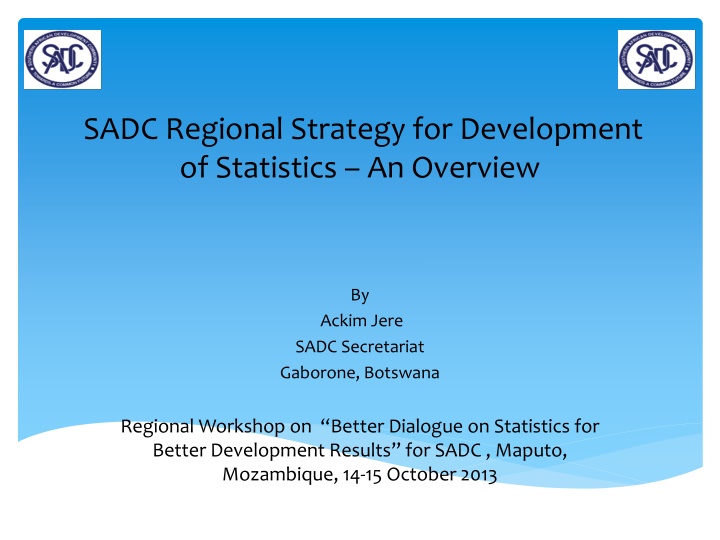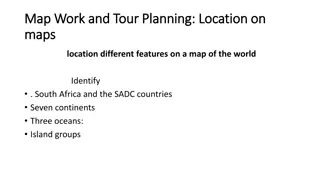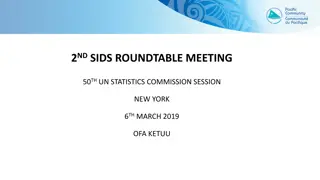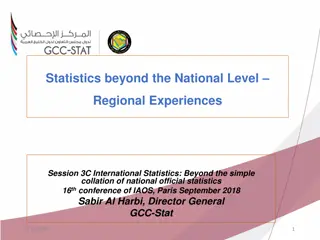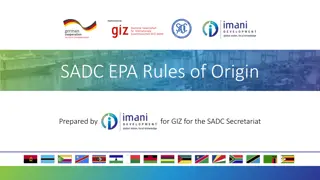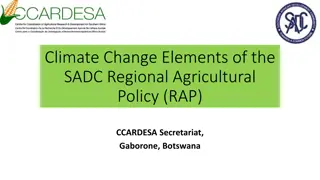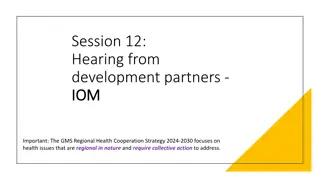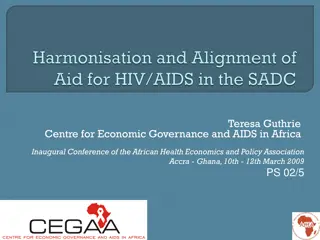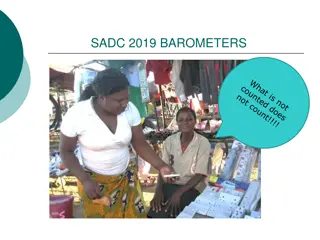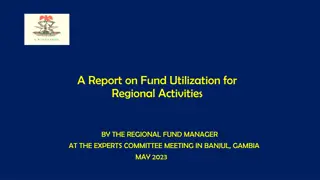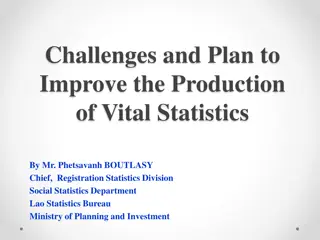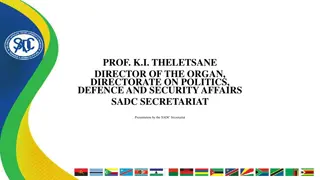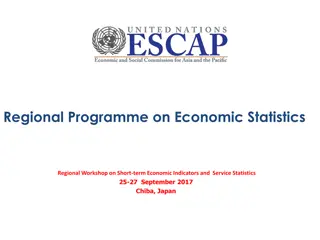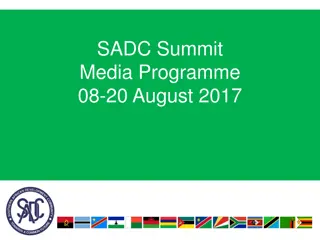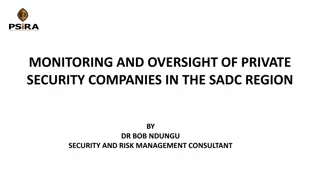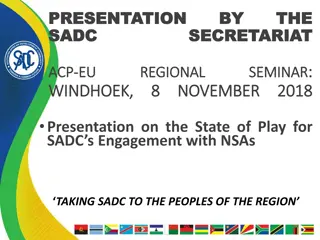SADC Regional Strategy for Development of Statistics
The SADC Regional Strategy for Development of Statistics aims to address outdated statistical strategies, align with the SADC Regional Indicative Strategic Development Plan, and meet the increasing demand for harmonized regional statistical data. The strategy development process involved collaboration among SADC member states to enhance regional integration and development monitoring. The ultimate goal is the eradication of poverty and improvement of well-being within the SADC region.
Uploaded on Oct 05, 2024 | 0 Views
Download Presentation

Please find below an Image/Link to download the presentation.
The content on the website is provided AS IS for your information and personal use only. It may not be sold, licensed, or shared on other websites without obtaining consent from the author.If you encounter any issues during the download, it is possible that the publisher has removed the file from their server.
You are allowed to download the files provided on this website for personal or commercial use, subject to the condition that they are used lawfully. All files are the property of their respective owners.
The content on the website is provided AS IS for your information and personal use only. It may not be sold, licensed, or shared on other websites without obtaining consent from the author.
E N D
Presentation Transcript
SADC Regional Strategy for Development of Statistics An Overview By Ackim Jere SADC Secretariat Gaborone, Botswana Regional Workshop on Better Dialogue on Statistics for Better Development Results for SADC , Maputo, Mozambique, 14-15 October 2013
OUTLINE 1. Introduction 2. Rationale for New Strategy Development 3. Process and Journey for Strategy 4. The Main Strategic Themes and Objectives 5. Implementation and Related Issues 6. M & E of Implementation of Strategy 7. Next Major Steps
SADC - 15 Member States Angola, Botswana, DRC, Lesotho, Madagascar, Malawi, Mauritius, Mozambique, Namibia, Seychelles, South Africa, Swaziland, Tanzania, Zambia, Zimbabwe
1- Introduction SADC established at the Summit of Heads of State and Government on 17 August 1992 in Windhoek, Namibia. SADC one of 8 Regional Economic Communities (RECs) in Africa duly recognized by African Union Commission. SADC currently composed of 15 member states, namely, Angola, Botswana, DRC, Lesotho, Madagascar, Mozambique, Namibia, Seychelles, South Africa, Swaziland, Tanzania, Zambia, and Zimbabwe Malawi, Mauritius, SADC s Ultimate Goal: Eradication of poverty and improvement of the well being of the people of the region through regional integration and cooperation.
2- Rationale for New Strategy Development Key Compelling factors for New Strategy Development included: 1998 SADC Statistical Strategy Document: Out-dated ( not addressing recent statistical developments, technological innovations, etc.) Not aligned to SADC Regional Indicative Strategic Development Plan (RISDP) Significant increase in demand over the years for harmonized regional statistical data, to support monitoring of progress of regional integration and development in general. Need for coordinating framework for regional statistical development and resource mobilisation
3 - Process and Strategy Development Journey Process: SADC Statistics Committee (SSC) provided oversight and policy direction Strategy Task Force (DRC, Lesotho, Mauritius, Mozambique (Chair), South Africa, Tanzania constituted by SSC provided technical backstopping, support and reviewed drafts of Strategy Secretariat coordinated and managed entire process; Secretariat drafted Strategy; Consultations with SADC Secretariat directorates/institutions, SWOT analysis, desk study undertaken; Task Force meetings in December 2011 and April 2012 in Maputo, Mozambique to agree on content, structure/format of strategy and to review drafts
3 - Process and Strategy Development Journey (cont d) Journey Activity Time Frame 1 15th SADC Statistics Committee (SSC) Meeting Gaborone, Botswana in September 2008: September 2008 Agreed on need to develop new Regional Strategy for Development of Statistics (RSDS) Tasked Mozambique in collaboration with Secretariat to prepare concept note on subject for consideration at its 16th meeting. 16th SSC meeting, Manzini, Swaziland Concept note presented, considered, and endorsed by SSC SSC also recommended to Council for approval for RSDS development Council approved development of RSDS Mobilisation of necessary resources for Strategy Development, Situation analysis, consultations, and desk study 18th SSC Maseru, Lesotho Formation of SSC Task Force comprising DRC, Lesotho, Mauritius, Mozambique (Chair), South Africa and Tanzania o support Strategy development process 2 June 2009 August 2009 August 2010/ April 2011 June 2011 3 4
3 - Process and Strategy Development Journey (cont d) Journey Activity Evaluation of the SADC 1998 Statistics Strategy/ Development of vision, mission and values / 1st Task Force Meeting, Maputo, December 2011 Strategy Zero Draft development Time Frame August December 2011 January February 2012 April 2012 5 6 2nd Task Force Meeting to review Zero Draft 7 Revision of Zero Draft /generate Draft 1 May 2012 8 Submit Draft 1 to SSC for comments/ Incorporate comments from SSC/ generate Draft 2 Submit revised Draft 2 with Incorporated comments/ generate Final Draft June 2012 9 June/July 2012 10 Submit Final Draft RSDS to Council of Ministers for noting (without cost estimates) Submit Final Draft RSDS to Council of Ministers for approval (with cost estimates) August 2012 11 February 2013 12
4 The Main Strategic Themes and Objectives RSDS Approved by SADC Council in February 2013, Maputo, Mozambique Six Main Strategic Themes Widen the scope and range of available regional statistical data and indicators 1 - 2 - Increase comparability and quality of prioritised regional statistics; 3 - Improve services to users and promote wider use of regional statistics; 4 - Strengthen stakeholder partnerships and coordination of the SADC Regional Statistical System (SRSS); 5 - Harness the latest innovations in Information, Communications, and Technology for statistical development in the region; and 6 - Promote statistical capacity building in the region
Theme 1 and Objectives Strategic Theme 1: Widen the scope and range of available regional statistical data and indicators Objective 1.1: monitoring and evaluation of progress in priority areas of the SADC Development Agenda identified. Statistical needs to support evidenced based (i) (ii) Objective 1.2: Effective data collection mechanisms, templates, and data transfer protocols, for compilation of regional statistics established. (iii) Objective 1.3: indicators sustainably. Prioritized comparable social and economic regional statistical publications for compiled
Theme 2 and Objectives Strategic Theme 2: Increase comparability and quality of prioritised regional statistics Objective 2.1: Consensus built and core staff trained on concepts and definitions, standards, classifications and frameworks suited for SADC for statistical areas and processes of the prioritized programme. regional harmonization Objective 2.2: the standardized and harmonized statistics developed. Manuals and guidelines for production of Objective 2.3: Agreed frameworks and common statistical standards and methods adapted to regional circumstances to facilitate harmonization of statistics implemented.
Theme 3 and Objectives Strategic Theme 3: Improve services to users and promote wider use of regional statistics Objective 3.1: Data dissemination and services to users of regional statistics enhanced. Objective 3.2: Advocacy strategy for statistics in the region developed and implemented
Theme 4 and Objectives Strategic Theme 4: Strengthen stakeholder partnerships and coordination of the SRSS (i) Objective 4.1: Policy and legal framework for the coordination of regional statistics developed and implemented. (i) Objective 4.2: User-producer forum at regional level to promote key stakeholder participation in regional statistical activities established. (i) Objective 4.3: respective statistical areas or processes to drive and guide the various harmonization processes established. Technical Working Groups/Task Forces for
Theme 5 and Objectives Strategic Theme 5: Harness State of the art innovations in Information, Communications, and Technology development in the region (i) Objective 5.1: Use of ICT for statistical production of statistics and data sharing among stakeholders of the SRSS enhanced. (i) Objective 5.2: Use of state-of-the-art ICT innovations for disseminating, archiving, statistics including integrated databases for socio- economic indicators on SADC enhanced. and storage of regional
Theme 6 and Objectives Strategic Theme 6: Promote Statistical Capacity Building in the Region Objective 6.1: Analytical capacity building both at national and Secretariat level enhanced. (i) (i) Objective statistics at national level implemented. 6.2: In-service training programmes in (ii) Objective 6.3: Partnerships between National Statistical System and training institutions in the region to promote training in official statistics enhanced.
5 - Implementation and Related Issues The Proposed Regional Statistical Programme is an integral part of the Strategy. Regional Statistical Programme provides details on proposed activities, expected outputs, broad tentative time frames, and institutional responsibilities for strategic themes. Annual Business Plans (Annual Work Plans) - main instrument for operationalizing, implementing, and monitoring the Regional Statistical Programme. Key components of institutional framework for implementation of the Strategy will include: Council of Ministers, SADC Statistics Committee and its Technical Committee/Task Forces; Secretariat and Focal Points
6- M & E of Strategy Implementation Monitoring, evaluation and reporting considered important aspects of Strategy implementation process. M & E framework mechanism proposed for Strategy implementation through mainly the following aspects: Annual Work Plans and Annual Progress reports; Mid-Term Review; and Final Review Risks and Assumptions for successful (or lack of it) implementation of Strategy identified.
7- Next Major Steps Through the Task Force ( Botswana, DRC, Lesotho, Mauritius, Malawi, Mozambique, RSA, Tanzania) to devise operationalisation mechanisms for Strategy. Review and resubmit cost estimates for Strategy implementation for Council consideration and approval Mobilization of Resources for Strategy implementation Development of advocacy and awareness measures or mechanisms to support Strategy implementation Disseminate Strategy widely to various key stakeholders
